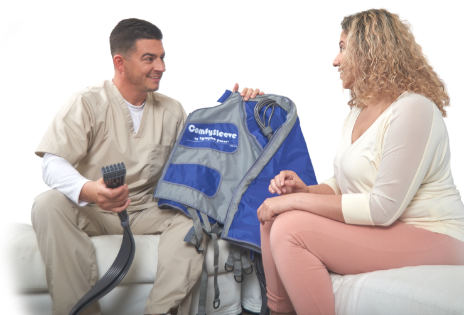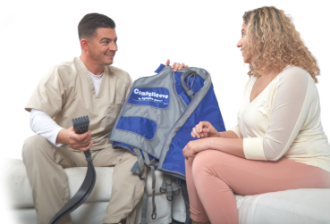On January 1, 2024, the Lymphedema Treatment Act (LTA) went into effect in the U.S. This law enables Medicare coverage for lymphedema compression supplies under a new benefit category.
The enactment of the LTA was a huge victory for the Founder and Executive Director of the Lymphedema Advocacy Group, Heather Ferguson. Ferguson started educating herself about lymphedema when her son received the diagnosis at just three months old. With no prior advocacy or legislative experience, she began a 13-year journey of working with lawmakers. Ferguson led a large-scale effort that involved people with lymphedema, caregivers, healthcare providers, industry partners, and other volunteers.
Lymphedema Treatment Act Coverage
In 2022, Ferguson’s vision of coverage for compression supplies became a reality when the Lymphedema Treatment Act passed. “The LTA benefit provides comprehensive coverage for lymphedema compression garments and supplies,” says Ferguson. “Compression is an essential part of treatment, and the previous gap in coverage left many patients unable to access the medical supplies they needed to manage this chronic condition.”
Healthcare providers currently play a key role in helping people with lymphedema receive the new benefit. Ferguson explains what providers need to know about the Lymphedema Treatment Act:
Who Does the Lymphedema Treatment Act Affect?
Anyone who has a lymphedema diagnosis and Medicare coverage can receive LTA benefits. The coverage applies to people with primary lymphedema as well as lymphedema due to any other condition or cause, such as cancer-related lymphedema.
What Does the Lymphedema Treatment Act Cover?
Lymphedema Treatment Act coverage applies to:
- Daytime compression garments: The benefit covers up to three daytime garments per affected body part every six months.
- Nighttime compression garments: The benefit covers up to two nighttime garments per affected body part every two years.
- Bandaging supplies: There is no limit on bandage supply coverage.
- Accessories for compression garments and bandaging supplies: There is no limit on accessories coverage.
The benefit covers standard-fit and custom-fit compression garments. However, providers must supply a clinical note explaining why a custom-fit garment is necessary.
What Isn’t Covered by the LTA?
Ferguson says people often ask why the LTA coverage is only for compression supplies. “Other items and services related to lymphedema treatment already fall under other Medicare benefit categories. These items include pumps, surgeries, and manual lymphatic drainage therapy,” she explains.
Lymphedema Treatment Act Eligibility Criteria
Providers can help people get LTA benefits by fulfilling the two benefit prerequisites:
1. Lymphedema diagnosis: The benefit requires a lymphedema diagnosis. Providers need to verify that this diagnosis appears in their patient’s medical record.
2. Prescription for compression garments: The LTA benefit also requires a prescription for compression garments. For custom-fit garments, the provider must give a supporting clinical note along with the prescription. Ferguson suggests speaking with a patient’s lymphedema therapist for details on why a custom-fit garment is needed.
Providers should also stay aware of new LTA-specific billing and diagnosis codes provided by the Centers for Medicare & Medicaid Services.
“As with any new policy, there are still some unanswered questions,” says Ferguson. “We expect there will be some glitches along the way.” However, she and her advocacy group plan to continue their work to make sure the LTA helps people as intended.
How Can Providers Help non-Medicare Patients?
The LTA directly applies only to Medicare, but people with other types of medical coverage will gain from this change, too:
Write Supply Prescriptions for non-Medicare Patients
Ferguson suggests that providers also write compression and bandaging supply prescriptions for non-Medicare patients living with lymphedema.
“A prescription is always necessary for insurance coverage, whether it’s Medicare or another insurance plan,” she says. “Be sure to have patients take their prescription to an in-network medical supplier. The supplier should give them a cost estimate. The estimate will show if the policy covers compression supplies.”
Watch for Widespread Policy Changes
“The new law can’t require non-Medicare policies to provide the benefits described by the LTA. But out of practicality, most other medical policies model their coverage after Medicare,” says Ferguson.
That means other policies should eventually add compression supply coverage. And some policies already cover compression supplies.
Continue to Educate Patients and Advocate for Coverage
“Other plans will see the financial sense in offering this coverage,” Ferguson anticipates. “The reality is people need compression garments to manage their condition. Without proper management, infections and complications are more common.” Insurers spend much more money treating these complications than preventing them, especially if treatment requires a hospital stay.
Ferguson says it will take time for the LTA benefits to appear in non-Medicare policies. But she’s optimistic and believes education is the key to the widespread adoption of LTA coverage.
To spread awareness, she suggests enlisting patients and advocates to help. “Encourage them to contact their own medical plans and ask their plans to match Medicare coverage.”
More Information
Find out more about the Lymphedema Treatment Act, including coverage details, approved compression suppliers, and answers to frequently asked questions. Providers and patients can also report denial of coverage, insufficient coverage, or other problems with LTA implementation.
Learn more about Lympha Press, pneumatic compression therapy that provides advanced in-home solutions for the treatment of lymphatic and circulatory diseases.








